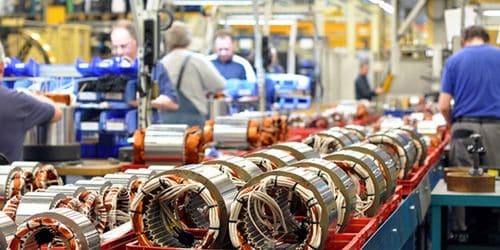Manufacturing is, without a doubt, an important component of the global economy. What is manufacturing, though? A manufacturing facility produces goods. Do you want to know more about manufacturing facilities? More information about manufacturing facility design, Takeda Covington, and Nikola Coolidge’s manufacturing facility (NMS) can be found in this article.
Read also: JUST IN TIME MANUFACTURING: Meaning and How It Works
What is a Manufacturing Facility?
Manufacturing facilities are an excellent source of revenue for entrepreneurs starting new businesses. It is a company that manufactures goods or provides services to other businesses. These factories are located in areas with high demand for the products they produce as well as low labor costs.
It is frequently a capital-intensive business that necessitates a significant time and resource investment. However, the results of a manufacturing facility can be highly profitable. Some manufacturing companies earn millions of dollars per year.
How do Manufacturing Facilities Work?
Everyday life is replete with manufacturing facilities. The vast majority of manufactured goods and services are housed in these facilities. They range from factories that manufacture simple household items to those that manufacture electronics. Manufacturing facilities function as large factories, producing goods in an efficient and dependable manner. It entails producing a product in a controlled environment to ensure quality. It also necessitates the coordination of numerous people and departments, making it a highly specialized job.
You must understand the entire manufacturing process, including design, engineering, production, logistics, and customer service, in order to become a successful manufacturer. Professional engineers and architects are frequently hired by manufacturers to design these facilities. These individuals will develop and construct the facility using blueprints and diagrams.
What are the Benefits of a Manufacturing Facility?
The increase in employment that occurs when new plants are opened is one of the most obvious benefits of a manufacturing facility. This not only creates jobs for residents, but it also creates a demand for products that would not have existed otherwise.
A manufacturing facility is a source of wealth for a region. This wealth can be derived from employee taxes, sales tax collected on goods sold, and company profits.
Some manufacturers construct their own facilities, while others outsource production to other firms that specialize in this type of work. However, the main reason people choose to build their own manufacturing facility is to have complete control over their products.
These facilities frequently have extensive quality control measures in place to ensure that products meet strict specifications. Furthermore, many plants can tailor their output to meet the specific needs of their customers.
Manufacturing Facility Types
Manufacturing facilities are not all large buildings filled with machinery and equipment, as some people believe. Factories produce a wide variety of goods, including food, clothing, and furniture. The type of manufacturing facility you select is primarily determined by the products and materials you intend to use.
Common types of manufacturing facilities include the following:
- Food production facility
- Furniture factories
- Clothing factories
- Textile facility
- Automotive facility
Some of these manufacturing plants are more complex than others, but the majority have a few common features. For example, food production facilities typically have large refrigerators, freezers, and ovens to produce food products such as pizza or sandwiches.
What are the Important Elements of a Manufacturing Facility?
The majority of manufacturing facilities require a few key components.
- Space
- Product line
- Quality control area
- Storage area
- Warehouse or distribution center
Examples of Manufacturing Facility
- Steel Mill: A steel mill is a factory that manufactures steel products. Steel mills are important to the economy because they create jobs and consumer goods. Steel is a widely used material in manufacturing.
- Aluminum Plant: An aluminum plant is a manufacturing facility that produces aluminum products. Aluminum is used in automobiles, appliances, and construction materials.
- Paper Mill: It is a factory that produces paper goods.
- Glass Manufacturing Facility: A manufacturing facility that produces glass products is referred to as a glass factory. Glass is used in a wide range of uses, including automobiles, structures, and appliances.
- Automotive Manufacturing Facility: A manufacturing facility that makes cars is known as an automotive plant. Cars are an essential part of our daily lives. Many people use automobiles to get around.
- Chemical Plant: A chemical plant is a factory that manufactures chemicals. Chemicals are essential in manufacturing because they are used in a wide variety of products, including plastics, paint, and cleaning supplies.
- Petroleum Refinery: An oil refinery is a manufacturing facility that converts crude oil into gasoline. Petroleum is a vital resource that is used in a variety of industries.
- Textile: A textile plant is a textile manufacturing facility. It uses in clothing, carpets, and many household items.
- Food Processing: A food processing plant is a manufacturing facility that produces products used in many foods, such as bread, pasta, and candy.
- Toy Factory: A toy factory is a manufacturing facility that produces toys for use in educational, work, and play environments.
Takeda Covington Manufacturing Facility
Takeda’s Covington Manufacturing Facility, located east of Atlanta, produces plasma-derived therapies to meet the needs of patients suffering from rare and complex chronic diseases. Their facility is the largest biotech manufacturing facility in Georgia and one of the largest in the world, spanning more than 1.1 million square feet and employing more than 1,100 people full-time.
Their 160-acre integrated campus consists of three manufacturing buildings, multiple laboratories, a warehouse with ambient, cold, and freezer storage, utility production, office space, and a stunning, two-story commons building with a full-service cafeteria, coffee bar, fitness center, and patio.
Working at the Georgia facility means having a one-of-a-kind chance to learn skills in a wide range of disciplines, including fractionation and purification manufacturing, filling, packaging, quality control, quality assurance, compliance, engineering, equipment maintenance, utilities, warehouse, supply chain, IT, automation, EHS, project management, training, and more.
Nikola Coolidge Manufacturing Facility
Nikola Corporation is reshaping the global transportation industry. Also, Nikola is driven to revolutionize the economic and environmental impact of commerce as we know it today as a designer and manufacturer of zero-tailpipe emission battery-electric and hydrogen-electric vehicles, electric vehicle drivetrains, vehicle components, energy storage systems, and hydrogen station infrastructure. Nikola Corporation was founded in 2015 and is headquartered in Phoenix, Arizona.
Facts About Nikola Coolidge Manufacturing Facility
Nikola Corporation (Nasdaq: NKLA), a global leader in zero-emission transportation and energy supply and infrastructure solutions, announced that its battery manufacturing facility is moving from Cypress, Calif. to its Coolidge, Ariz. manufacturing facility. The relocation, which is expected to be completed in early Q3, consolidates Nikola’s truck assembly, fuel cell power module assembly, and battery module and pack production under one roof, and includes battery line automation aimed at improving quality and increasing efficiencies.
The company intends to maintain manufacturing operations in Cypress through the end of Q2 2023, while it brings its production capabilities in Coolidge online and works through a detailed transition plan to prevent manufacturing disruptions.
“This decision reaffirms our commitment to finding ways to optimize our cost structure and create a sustainable business model,” said Michael Lohscheller, President and CEO of Nikola Corporation. “We remain focused on meeting our 2023 milestones, including pack and module production targets.”
A battery engineering presence is expected to remain in California at a separate facility to focus on the development of Nikola’s next-generation battery management system software and modules.
Manufacturing Facility Design
The goal of most manufacturing operations is straightforward: create a lean manufacturing system to streamline production and ensure a smooth flow of work, materials, and information. The old adage “time is money” is true in the manufacturing industry.
What Are the Conditions for an Effective Layout of a Manufacturing Facility?
Effective manufacturing operations should maximize material handling efficiency and minimize space utilization. This includes:
- Ensuring efficient use of labor
- Eliminating bottlenecks
- Facilitating effective communication between employees and supervisors
- Reducing downtime
- Making sure material/product movement is not static
- Considering flexibility for future workflow changes
There are several ways to ensure that facilities meet the aforementioned requirements in order to design an effective layout that streamlines production and promotes a lean manufacturing process. There are three basic facility designs used in manufacturing, depending on the operation, all with the goal of meeting the requirements listed above.
#1. Basic Facility Layouts for Manufacturing
Hundreds of hybrid design layouts exist, but they are all based on three basic design concepts intended to meet the needs of specific types of manufacturing. These layout designs include process layout design, fixed-position layout design, and product layout design. Each layout has its own set of advantages and disadvantages, and each uses a different type of material handling setup. In fact, material handling is an important component of all three layouts, but it is practically required for the product layout design approach.
#2. Product Layout Design
One of the most common facility layouts in the manufacturing industry is product layout design. Product layouts (also known as assembly lines) organize activities in a production line according to the sequence of operations required to assemble a specific product. Product layouts are appropriate for mass production or repetitive operations with consistent demand and high volume.
As a result, product layouts are more autonomous than the other designs mentioned above. A product layout design requires that materials be moved in one direction and in the same pattern along the assembly line. The primary concern for product layout design is balancing the assembly line so that no single workstation becomes a bottleneck and impedes the flow of work through the line. The efficiency and ease of use of the product layout design are its advantages. The disadvantage is its rigidity.
#3. Monorail Systems for Increased Flexibility
Monorails can be freestanding or ceiling-mounted, depending on the needs of the specific facility. If your facility has multiple overhead obstructions, a freestanding system is ideal. However, because most product layout manufacturing facilities have narrow aisles and floor obstructions, a ceiling-mounted monorail is the most versatile and ergonomic way to streamline your production process and improve flexibility.
Considerations when Choosing a Site for a Manufacturing Facility
To determine the project’s long-term success, the following ten factors should be considered before committing to the purchase of a site or structure. Many of these factors are intertwined, but all too often, one or more are overlooked during the pre-purchase planning process.
#1. Existing buildings vs. greenfield sites
Existing buildings can provide suitable manufacturing operations solutions. In many cases, this approach can be faster and less expensive than building a new facility. The cost of adapting a building’s existing, often obsolete utilities and features, on the other hand, may far outweigh the cost of investing in new construction on a greenfield site.
#2. Financial incentives
Communities frequently offer incentive packages in order to sell vacant properties or attract businesses and jobs. Sometimes abandoned mills, factories, and speculative buildings become such a burden to public agencies and economic development organizations that they give them away for free—or at a very low cost.
#3. Scalability
How fast a facility can be operational and produce product often determines its overall success—and can seem like the end game. However, the key to a project’s long-term success is that it serves its purpose for many years to come. To do so, the facility and site must be physically capable of accommodating future expansion and growth.
#4. Project cost expectations
Initial project cost perceptions are frequently based on inaccurate information. Too often, construction cost estimates are based on outdated information or a “square foot cost” obtained from a local general contractor by an economic developer.
#5. Infrastructure
Owners and their representatives must also determine the cost of utilities and transportation (such as highways, rail, air, and waterways).
- Transportation: Determine the modes of transportation required for raw material deliveries, finished product distribution, and internal material movement, and evaluate the site’s proximity to these options.
- Utilities: Examine the plant’s communications, energy, water, and wastewater requirements, as well as the available supply sources.
Electrical, sprinkler, and mechanical systems are also important to address.
#6. Supply chain and customer access
Logistics, as it relates to suppliers and end users, is another important factor in site selection. An experienced consultant can assist in analyzing locations for raw material sources, suppliers, distribution centers, and customers. A location that reduces the facility’s mileage between customers and materials reduces transportation costs. Customers with the highest priority should be prioritized.
#7. Availability and wages of local labor
A great quote for a nostalgic baseball film is “If you build it, they will come,” but not for a manufacturing company opening a facility in a new location. A labor market analysis is required to determine whether there is a current (and future) workforce available with the necessary skill sets.
#8. Environmental factors
Is the site located on a floodplain, in a seismic zone, or in a humid region? These are just a few of the variables that can have an impact on both construction and operational requirements. Using an EPC firm that has experience with various types of facility requirements can provide valuable insight and perspectives. A site visit will not help you see the challenges that are hidden on the site.
#9. Codes and regulations
The regulatory environment must be thoroughly examined, from building and fire codes to permitting and zoning. This is crucial for existing facilities because the building was originally designed and built for a different purpose. Regulatory requirements are highly specific to the project’s output and must be reviewed with environmental and/or legal support.
#10. Involvement of knowledgeable stakeholders
Don’t delegate decision-making to a small group of people. Involve the team that will eventually own, runs, and maintains the facility to ensure they agree on on-site search parameters. Provide computer simulations, such as those generated by BIM software, to assist teams in quickly running scenarios that test the aforementioned variables.
What is in a Manufacturing Facility?
A “manufacturing facility” refers to structures and buildings, as well as machinery and equipment.
What is a Manufacturing Facility Called?
A manufacturing plant, production plant, or factory
What are the Types of Manufacturing Facilities?
The type of factory operations in place is determined by the product or products produced, as well as the demand for them.
- Repetitive assembly line.
- Discrete assembly line.
- Job shop.
What are the 4 Types of Manufacturing?
Which of the four manufacturing processes are you talking about?
- Molding and casting.
- Machining.
- Joining.
- Shearing and forming
What Makes a Good Manufacturing Facility?
A high-quality manufacturing plant strives to create an environment at work that encourages employees to give their all.
Conclusion
Manufacturing facilities are an essential part of our lives. They have a long history that dates back to the industrial revolution and continue to play an important role in our economy today. There are numerous manufacturing facilities, each serving a distinct purpose and function. Given the ever-changing landscape of technology and industry, it is crucial to stay current on the latest developments in manufacturing facility technology and processes.
Related Articles
- OFFICE LAYOUT: Meaning, Ideas & Guide
- Facilities Management Systems: Top Picks In 2023
- Creative Solutions For Optimizing Office Layout






